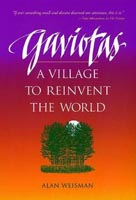Granny's Country Store > Holistic Living > Sustainable Living Stories | Search | View Cart
Gaviotas
A Village to Reinvent the World
by Alan Weisman
Review by Thomas J. Elpel and Phil Hacker

The eastern savannas of Colombia, known as the llanos, are among the most challenging environments on Earth, with brackish surface water and barren soils that are nearly toxic with natural aluminum--just about impossible to grow anything on. But an intrepid visionary named Paolo Lugari concluded that with continued population growth and worldwide environmental degradation, one day people would be forced to live in places like that. In 1971 he set out to create a sustainable village there, reasoning that if a community could survive there, then it would be possible to live anywhere. The village was named Gaviotas after the graceful river terns common in the area, los gaviotas. It was sixteen hours from the nearest city over treacherous terrain where multiple flats were common in a one-way journey.
The early inhabitants of Gaviotas were mostly scientists and specialists that had vision, but lacked the resources of the industrialized countries. Instead, they worked with industrial leftovers and basic materials to invent sustainable technologies such as wind turbines for electricity, super-efficient manual pumps, solar water heaters to heat water, and solar kettles to sterilize the drinking water with sunshine. When they were unable to grow food in the local soil, they switched to hydroponics to grow their food. As word of their accomplishments spread, they were awarded grants and contracts to install their unique inventions at other remote communities. They brought homeless kids in off the streets of Bogata and trained them to become solar engineers. Their work was known by the president of Columbia, who installed one of their solar water heaters on his palace and recognized by the United Nations.
Gaviotas was like an island of peace in a country embroiled in decades of political turmoil, where ongoing battles, kidnappings, and murders for hire were common place. But although different factions controlled the llanos from time to time, the people of Gaviotas never carried weapons nor took sides, and all parties in Columbia recognized that their work was too important to interfere in anyway.
Eventually, Columbia discovered its own oil and natural gas resources, and national interest in sustainable technologies went by the wayside. The grants and government contracts dried up, and with them the factories built at Gaviotas to build their efficient pumps, water heaters, and windmills. The community of Gaviotas was forced to reinvent itself to survive, and did so by cultivating pines on the barren savanna. They discovered accidentally that, after an initial start in their nursery, pine trees grew like weeds on the savanna, becoming a productive and sustainable source of pine resin, which they could harvest and sell commercially. The native jungle plants, found naturally along the creeks, quickly colonized the ground in the shade of the pines, successfully turning the savanna into jungle, even while other parts of the country were being deforested and denuded by industry.
Alan Weisman tells the story of Gaviotas through the description of its people and their lives, along with its collective accomplishments as a community. It is the story of the village that pioneered appropriate technology and the creation of ecovillages. Inspiring and uplifting, Gaviotas existence and Alan Weisman's book serve to motivate by example. See also Friends of Gaviotas.